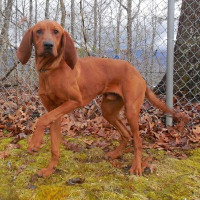Appearance of the Redbone Coonhound
|
| The Redbone Coonhound is a strong, streamlined, medium-sized dog designed to move swiftly across swamps, rocky hills and wooded areas. Its gait is well balanced, with head and tail raised. This dog is squarely proportioned and is slightly longer than it is tall. A long, slightly arched neck leads to a broad, slightly domed skull, with a well-balanced muzzle and large, open nostrils in a black nose. The face carries a pleading expression with round, dark brown or hazel eyes, and large, drooping ears moderately low on the head. A strong, straight back and broad chest are supported by well-muscled legs. This breed has cat-like paws that are compact and well-padded with arched toes. The tail is of medium length. The coat is composed of short, glossy hair. In general, the color is a rich, solid mahogany, although there may be a small amount of white on the chest and feet. |
Temperament of the Redbone Coonhound
|
| The Redbone Coonhound is a devoted and loyal family dog, intelligent and eager to please. They are affectionate, easy-going dogs that are playful and love their family's attention, without being overly demanding. Although they love children, Redbones can be too restless for toddlers when they're young. This breed can coexist peacefully with other animals, but can also regard small animals such as cats as prey and chase them away. They do best with cats if bred with them. The Redbone can also behave well with strangers, but can take on the role of guard dog. Good socialization while young can acclimatize this dog to different animals and people. The Redbone's most distinctive feature is its musical, clear barking voice, which can carry over long distances. These dogs are independent and stubborn, and can prove difficult to train. Start training early with short sessions, using positive reinforcement and treat rewards. Although they are more responsive to training than other breeds, obedience is not their forte. Energy abounds in this breed, which needs regular, daily exercise. Redbones are versatile and can hunt and swim in a variety of terrains. If hunting isn't on the agenda, these adaptable dogs can also benefit from agility and obedience trials, tracking, herding, dog shows and even employment in the search and rescue division. |
Needs and activities of the Redbone Coonhound
|
| The Redbone Coonhound is happy, well-balanced and very good with children. He can be surprisingly affectionate and has a pleasant voice. He loves being with his people. If raised indoors as a puppy, he will adapt well to family life. Coonhounds are all instinctive hunters, and it's not difficult to train the breed to follow scent and display a quarry. Redbones have a strong desire to please their master. Redbones are hot noses, able to locate raccoons in trees, faster than many other coonhounds. Like other coonhounds, Redbones are alert, fast and able to work in all weathers on difficult terrain. Their agility benefits them when hunting fenced terrain or steep, rocky terrain. With the iron grain of a Terrier and the pumping stamina of a Husky, the Redbone is every hunter's warm dream come true. A natural tree instinct has been bred into the Redbone, making it a raccoon hunting specialist. But it's also proficient in trolling and treeing bear, cougar and bobcat. When used as a game animal, Redbones often hunt in packs. Redbones are known to make excellent water dogs. In the home, they are affectionate and gentle. The Redbone should be well socialized at an early age and taught simple obedience like walking on a leash. Be careful with cats and other non-canine pets. If raised with a kitten, they can be fine, but some Redbone Coonhounds try to chase cats like raccoons. Some Redbone Coonhounds drool a lot, while others don't at all. It all depends on the shape of the lips. The coonhound mouth will drool a lot. The Redbone Coonhound needs a firm, but calm, confident and consistent pack leader to be mentally stable. |
Maintenance of the Redbone Coonhound
|
| This breed is generally easy to care for, requiring weekly brushing, as the Redbone Coonhound does not shed and is not hypoallergenic. Redbone Coonhounds are known to have a musty scent that can be controlled with normal baths. Long, floppy ears need to be cleaned regularly and kept dry to avoid the ear infections this breed is prone to. Nails grow quickly and need to be trimmed regularly to avoid breakage and cracking. This dog loves and demands frequent daily exercise and will get bored with nothing to do. The Coonhound can benefit from long walks and jogging, space to run, swim and hunt. Keep this dog on a leash or fenced in, otherwise he may run after a scent. Redbone can live indoors or outdoors, and does best in a rural home that allows him to hunt and yelp. Make sure you spend quality time with this dog, as if left to his own devices, he'll be looking for companionship. The Redbone tends to be obese, so avoid overfeeding him. |








 English (United Kingdom)
English (United Kingdom)